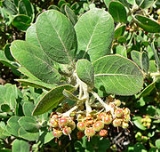
Arctostaphylos confertiflora
Encyclopedia
Arctostaphylos confertiflora is a rare species of manzanita
known by the common name Santa Rosa Island Manzanita. This shrub
is endemic to California
, where it grows on the sandstone bluffs of Santa Rosa Island
in the Channel Islands
. This manzanita is listed as an endangered species
by the United States Government. There are a few individuals in two locations on the island, and most of them are threatened by cattle
, elk
, and deer
, which eat them.
This is a small, twisting manzanita with blood red to gray bark and glandular bristles on its branches. The leaves are light, dull green, glandular and hairy or bristly. The small flowers are rounded and milky white, less often pale pink, and bunched densely in inflorescence
s. The fruits are fuzzy drupe
s around a centimeter in diameter.
Arctostaphylos
Arctostaphylos is a genus of plants comprised by the manzanitas and bearberries. They are shrubs or small trees.There are about 60 species of Arctostaphylos, ranging from ground-hugging arctic, coastal, and mountain species to small trees up to 6 m tall. Most are evergreen , with small oval...
known by the common name Santa Rosa Island Manzanita. This shrub
Shrub
A shrub or bush is distinguished from a tree by its multiple stems and shorter height, usually under 5–6 m tall. A large number of plants may become either shrubs or trees, depending on the growing conditions they experience...
is endemic to California
California
California is a state located on the West Coast of the United States. It is by far the most populous U.S. state, and the third-largest by land area...
, where it grows on the sandstone bluffs of Santa Rosa Island
Santa Rosa Island, California
Santa Rosa Island is the second largest of the Channel Islands of California at 53,195 acres . Defined by the United States Census Bureau as Block 3009, Block Group 3, Census Tract 29.10 of Santa Barbara County, California, the 2000 census showed an official population of 2 persons. It is part of...
in the Channel Islands
Channel Islands of California
The Channel Islands of California are a chain of eight islands located in the Pacific Ocean off the coast of Southern California along the Santa Barbara Channel in the United States of America...
. This manzanita is listed as an endangered species
Endangered species
An endangered species is a population of organisms which is at risk of becoming extinct because it is either few in numbers, or threatened by changing environmental or predation parameters...
by the United States Government. There are a few individuals in two locations on the island, and most of them are threatened by cattle
Cattle
Cattle are the most common type of large domesticated ungulates. They are a prominent modern member of the subfamily Bovinae, are the most widespread species of the genus Bos, and are most commonly classified collectively as Bos primigenius...
, elk
Elk
The Elk is the large deer, also called Cervus canadensis or wapiti, of North America and eastern Asia.Elk may also refer to:Other antlered mammals:...
, and deer
Deer
Deer are the ruminant mammals forming the family Cervidae. Species in the Cervidae family include white-tailed deer, elk, moose, red deer, reindeer, fallow deer, roe deer and chital. Male deer of all species and female reindeer grow and shed new antlers each year...
, which eat them.
This is a small, twisting manzanita with blood red to gray bark and glandular bristles on its branches. The leaves are light, dull green, glandular and hairy or bristly. The small flowers are rounded and milky white, less often pale pink, and bunched densely in inflorescence
Inflorescence
An inflorescence is a group or cluster of flowers arranged on a stem that is composed of a main branch or a complicated arrangement of branches. Strictly, it is the part of the shoot of seed plants where flowers are formed and which is accordingly modified...
s. The fruits are fuzzy drupe
Drupe
In botany, a drupe is a fruit in which an outer fleshy part surrounds a shell of hardened endocarp with a seed inside. These fruits develop from a single carpel, and mostly from flowers with superior ovaries...
s around a centimeter in diameter.

